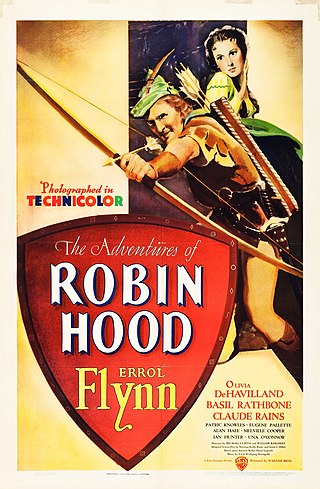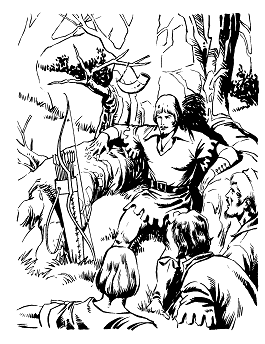"Robin Hood and the Golden Arrow" is Child ballad 152. [1] [2] It features an archery competition for a golden (or silver) arrow that has long appeared in Robin Hood tales, but it is the oldest recorded one where Robin's disguise prevents his detection. [3]
The sheriff of Nottingham complains to King Richard of Robin Hood. The king declares that the sheriff is his sheriff and must catch him. The sheriff decides to trap him with an archery contest, where the prizes would be arrows with golden and silver heads. Robin decides to compete, despite a warning from David of Doncaster that it is a trap, though he does order the Merry Men to attend in great number and disguised. Robin goes in disguise and wins, escaping without being recognized. At Little John's advice, a letter is written to the sheriff and shot into his hall, telling the truth. [1] [4]
There are many archery contests in the legends of Robin Hood, but many of them are clearly derived from this source, as in Howard Pyle's The Merry Adventures of Robin Hood . [5] Other variants are more closely related to the older contest included in A Gest of Robyn Hode , where they are recognized and must fight free.
The story is portrayed in the 1938 film The Adventures of Robin Hood starring Errol Flynn in which Prince John, Guy of Gisbourne, and the Sheriff of Nottingham plan to trap Robin as the most likely winner of the contest, knowing of his attraction to the Lady Marian, and Robin splits the arrow of another contestant to thus win the prize of the golden arrow given by her hand. An altered version of the tale appears in the first episode of the Robin of Sherwood television series, in which the prize offered is a silver arrow belonging to Herne the Hunter as a means of luring Robin to the castle. This episode is parodied in Mel Brooks' Robin Hood: Men in Tights in which the contest itself seduces Robin. The event also appears in the animated Disney film, with the prizes instead being a golden arrow and a kiss from Maid Marian. The event also appears in the computer game Conquests of the Longbow: The Legend of Robin Hood , where the player, as Robin Hood, can win a golden arrow in an archery contest, thereby adding its value (15000 marks) to a ransom to free Richard the Lionheart from prison abroad. The event also appears in the Doctor Who episode "Robot of Sherwood," with Robin splitting another contestant’s arrow, before the Doctor splits Robin’s arrow.
{{cite book}}: |work= ignored (help)
The Adventures of Robin Hood is a 1938 American Technicolor epic swashbuckler film from Warner Bros. Pictures. It was produced by Hal B. Wallis and Henry Blanke, directed by Michael Curtiz, and stars Errol Flynn, Olivia de Havilland, Basil Rathbone, Claude Rains, Patric Knowles, Eugene Pallette, and Alan Hale. The film is particularly noted for its Academy Award-winning score by Erich Wolfgang Korngold.

Sir Guy of Gisbourne is a character from the Robin Hood legends of English folklore. He first appears in "Robin Hood and Guy of Gisborne", where he is an assassin who attempts to kill Robin Hood but is killed by him. In later depictions, he has become a romantic rival to Robin Hood for Maid Marian's love.
Maid Marian is the heroine of the Robin Hood legend in English folklore, often taken to be his lover. She is not mentioned in the early, medieval versions of the legend, but was the subject of at least two plays by 1600. Her history and circumstances are obscure, but she commanded high respect in Robin’s circle for her courage and independence as well as her beauty and loyalty. For this reason, she is celebrated by feminist commentators as one of the early strong female characters in English literature.
Much, the Miller's Son is one of the Merry Men in the tales of Robin Hood. He appears in some of the oldest ballads, A Gest of Robyn Hode and Robin Hood and the Monk, as one of the company.
The Bishop of Hereford is a character in the Robin Hood legend. He is typically portrayed as a wealthy and greedy clergyman who is robbed by Robin and his Merry Men.
Alan-a-Dale is a figure in the Robin Hood legend. According to the stories, he was a wandering minstrel who became a member of Robin's band of outlaws, the "Merry Men".
Will Scarlet is a prominent member of Robin Hood's Merry Men. He is present in the earliest ballads along with Little John and Much the Miller's Son.

Adam Bell was a legendary English outlaw. He and his companions William of Cloudsley and Clym of the Clough lived in Inglewood Forest near Carlisle and were figures similar to Robin Hood. Their story is told in Child Ballad 116 entitled Adam Bell, Clym of the Cloughe and Wyllyam of Cloudeslee. The basis of the tale has historical roots in the criminal activities of the Folville and Coterel gangs. At one point William of Cloudsley, who is famed as an archer, shoots an arrow through an apple on his son's head at six score paces, a feat also ascribed to William Tell and other heroes. The oldest printed copy of this ballad dates from 1505 and was printed by Wynkyn de Worde. There are notable parallels between this ballad and that of Robin Hood and the Monk, but whether either legend was the source for the other cannot be established.

The Merry Adventures of Robin Hood of Great Renown in Nottinghamshire is an 1883 novel by the American illustrator and writer Howard Pyle. Pyle compiled the traditional Robin Hood ballads as a series of episodes of a coherent narrative. For his characters' dialog, Pyle adapted the late Middle English of the ballads into a dialect suitable for children.
Richard at the Lee is a major character in the early medieval ballads of Robin Hood, especially the lengthy ballad A Gest of Robyn Hode, and has reappeared in Robin Hood tales throughout the centuries.
Gilbert Whitehand is a member of Robin Hood's Merry Men about whom next to nothing is known. It is possible that he is a character known from oral literature, with only allusions remaining in written literature.
Robin Hood and the Butcher is a story in the Robin Hood canon which has survived as, among other forms, a late seventeenth-century English broadside ballad, and is one of several ballads about the medieval folk hero that form part of the Child ballad collection, which is one of the most comprehensive collections of traditional English ballads. It may have been derived from the similar Robin Hood and the Potter.
The King’s Disguise, and Friendship with Robin Hood is Child ballad 151. It holds the common tradition of the end of Robin Hood's outlawry, although it is a relatively late ballad, as it puts Robin firmly in King Richard's reign. Also, unlike "A Gest of Robyn Hode", an earlier version, the king is not acting out of the need to suppress Robin.

The Merry Men are the group of outlaws who follow Robin Hood in English literature and folklore. The group appears in the earliest ballads about Robin Hood and remains popular in modern adaptations.

The Outlaws of Sherwood is a retelling of the legend of Robin Hood by Robin McKinley. In McKinley's afterword, she says, "The retellings through the centuries have echoed concurrent preoccupations." The story includes both the traditional Robin Hood characters — Little John, Much, Friar Tuck, Marian and Alan-a-dale — and characters of McKinley's own invention. Notably, three of the most important characters are women, all of whom escape marriage to prospective spouses chosen by their fathers.
The Sheriff of Nottingham is the main antagonist in the legend of Robin Hood. He is generally depicted as an unjust tyrant who mistreats the local people of Nottinghamshire, subjecting them to unaffordable taxes. Robin Hood fights against him, stealing from the rich, and the Sheriff, in order to give to the poor; it is this characteristic for which Robin Hood is best known. The Sheriff is considered the archenemy of Robin Hood, as he is the most recurring enemy of the well-known outlaw.

Robin Hood is a fictional character appearing in media published by DC Comics, based on the legendary character of the same name. The character debuted in New Adventure Comics vol. 1 #23, and was created by Sven Elven.

Tom and Jerry: Robin Hood and His Merry Mouse is a 2012 American animated direct-to-video action-adventure musical comedy film starring the seven-time Academy Award-winning cat-and-mouse duo Tom and Jerry as well as the historical and heroic outlaw Robin Hood. Produced by Warner Bros. Animation and Turner Entertainment Co., the film was released on DVD and Blu-ray on September 28, 2012.

"Robot of Sherwood" is the third episode of the eighth series of the British science fiction television programme Doctor Who. It was written by Mark Gatiss and directed by Paul Murphy, and was first broadcast on BBC One on 6 September 2014.